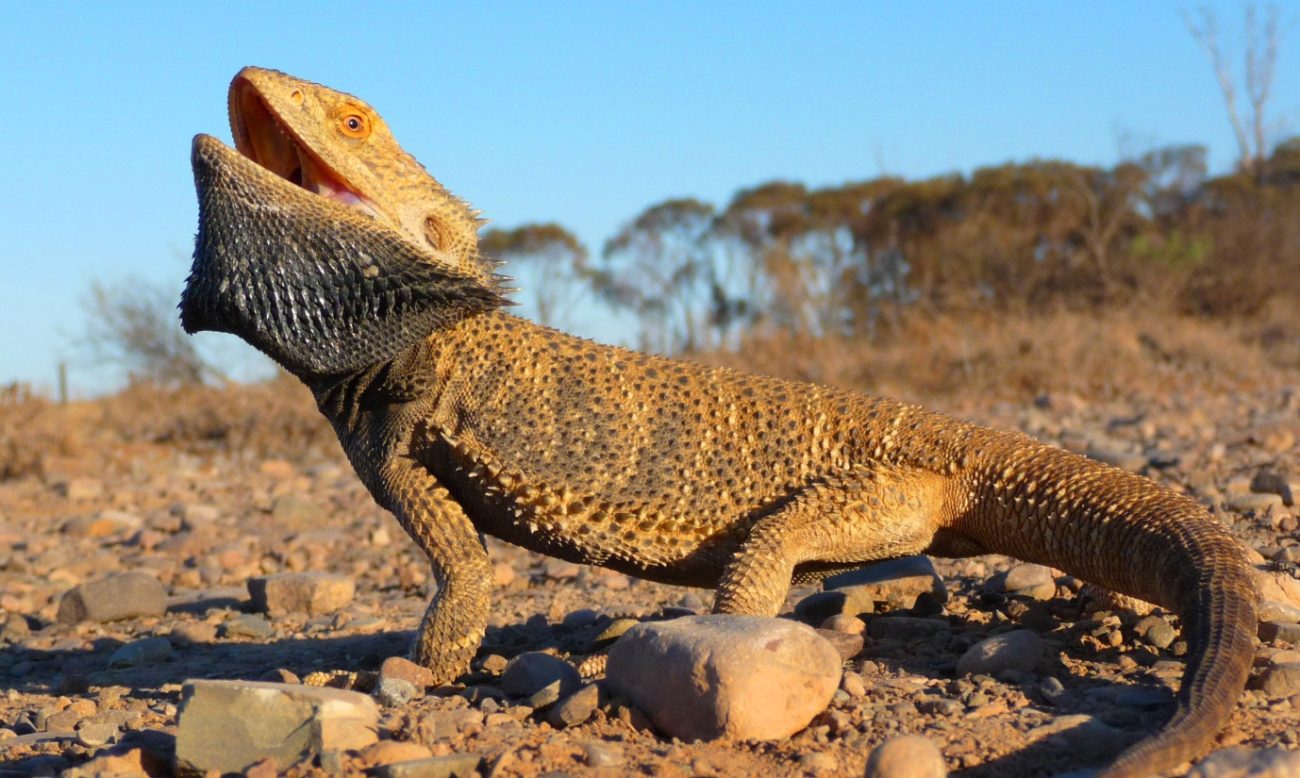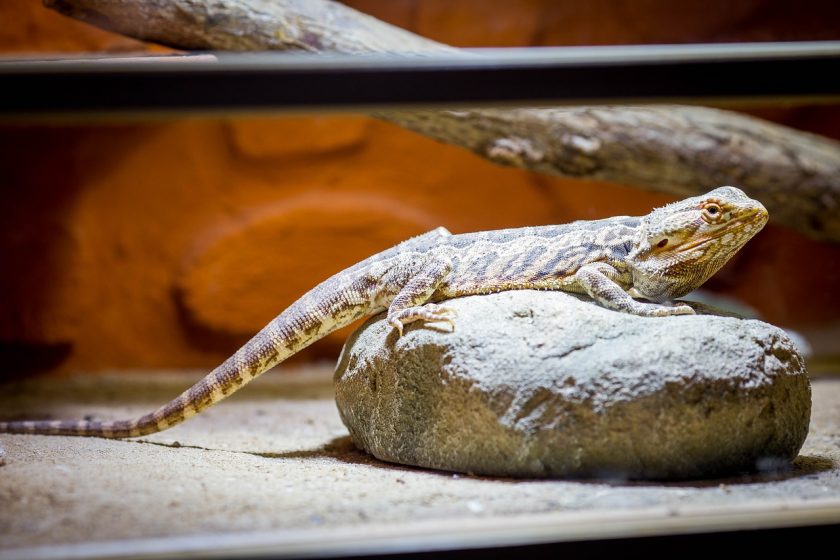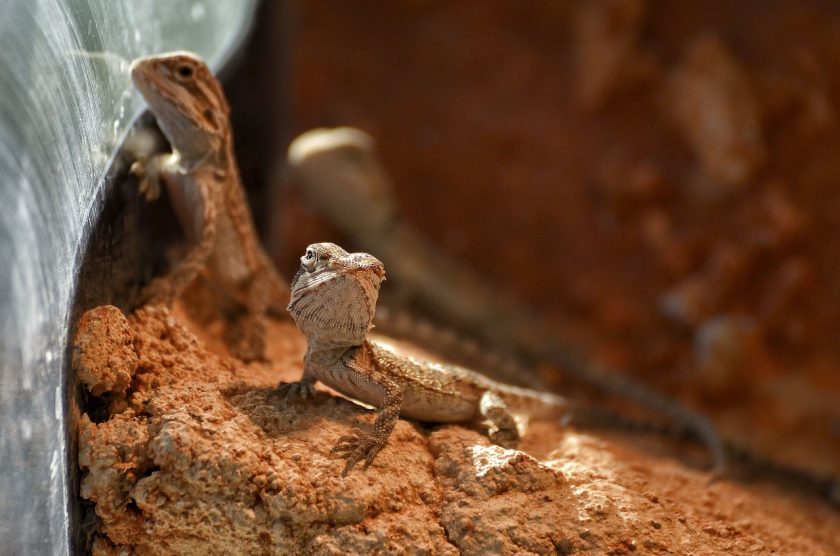Picture a creature that relies heavily on the right mix of temperature and humidity for survival. This is the life of your bearded dragon, a fascinating reptile from dry deserts. So, as a reptile enthusiast – it’s important to understand the nature of bearded dragons, which are cold-blooded and come from desert areas. And this knowledge is necessary to create the perfect living conditions for them. This includes providing them with:
- Temperature Gradient: This is important for their daily need to control body temperature. It gives them places to bask, relax, and cool down.
- Basking Spot: It’s super important for absorbing heat and UVB. And this helps with digestion and keeps them healthy overall.
- Cool Zone: This area gives them a break from the heat – just like the shady spots they find in nature.
- Nighttime Conditions: It’s like the cooler nights they would experience in their natural habitat, which is important for good rest.
- Humidity Control: This helps keep their skin healthy and hydrated, prevents breathing problems, and helps them shed their skin.
Each of these elements plays a pivotal role in the well-being of your bearded dragon.
Ready to delve deeper? Let’s explore how you can create the ideal habitat for your scaly friend.
Why Bearded Dragons Need the Right Tank Temperature?
Keeping the right temperature in a bearded dragon’s tank is crucial. These reptiles come from Australia’s hot deserts, savannas, and woodlands. They are ectothermic, meaning they rely on heat from their surroundings to stay warm because they can’t make their own body heat. A perfect home for a bearded dragon should be like their natural habitat, with different temperature areas for their best health.
Like sunlight, overhead heating is vital for their metabolism and overall health. If the temperature isn’t right, they can have:
- Digestion problems
- Get stressed
- Or even die.
So, controlling the temperature accurately is key for them to stay healthy.
Ideal Temperature Range for a Bearded Dragon
As mentioned earlier, having the right temperature range in a bearded dragon’s tank is crucial for their health. And this means setting up a tank with areas of different temperatures, just like where they come from naturally. These areas include:
- There is a warm basking spot at one end of the tank.
- A cooler area at the other end.
- A comfortably warm middle area.
This setup is really important for bearded dragons of all ages. It lets them control their body temperature during the day by moving between these different areas.
1. Basking Spot Temperature
The basking area – the vivarium’s hottest part – is crucial for the bearded dragon to absorb heat and UVB light. The best temperature for the basking spot changes depending on how old the dragon is:
- Baby bearded dragon (0–6 Months): Needs 95°-110°F (35°-43°C). And they need this extra warmth for energy while they grow quickly.
- Juvenile bearded dragon (6–12 months): Best at 95°-100°F (35°-38°C).
- Adult bearded dragons (1+ years): Should have 90°-93°F (32°-34°C).
2. Overall Temperature
The tank’s overall temperature, excluding the basking & cool spots, should stay between 72-99°F. This is measured in the tank’s middle, halfway between the basking area and the cool spot. So, keeping a steady temperature here ensures the dragon can move away from the basking spot’s heat when it wants to.
3. Cool Spot Temperature (Hide Spot)
Unlike us, bearded dragons can’t sweat to cool down. They rely on environmental means, such as hiding in cooler areas. The tank should have a cool or hiding spot opposite the basking area. This cool spot is important for their temperature control and should be kept at 70-85°F. It mimics their natural behavior of seeking shelter under rocks or logs in the wild.
4. Night Time Temperature
Despite originating from hot deserts, bearded dragons experience cooler nights. At night, the temperature in their tank should go down a bit but stay above 65-75°F. And, in most homes, this temperature range happens naturally, so you usually don’t need the heater on at night. But it’s a good idea to check the temperature each morning to ensure it doesn’t get too cold. If it is near 65°F, adjust the heater timing to reduce the off period.
How Much Is Too Cold for a Bearded Dragon?
For bearded dragons, the threshold for cold temperatures is crucial. During the day, the coolest part of their home should be over 70°F (22°C), and the basking spot should be warmer, between 95-110°F (40-42°C). It’s okay if the temperature drops to about 65°F (18°C) at night, but it shouldn’t go below that. Temperatures lower than 60°F (16°C) can be risky, and there’s no benefit in exposing them to such lows.
How To Set Up Effective Heating System for Bearded Dragon
Selecting the right heating equipment is paramount for your bearded dragon’s habitat. Here, I’ve outlined some key components and tips for setting up an effective heating system:
- Overhead Heat Source: Prefer an overhead heat source – like a high-wattage halogen bulb in a dome heat lamp with a ceramic socket. This setup gives the right basking temperatures and creates a good heat gradient. Heating elements under the tank, like heat mats, are less effective.
- Halogen Flood Bulbs: I recommend using at least two halogen flood bulbs. These bulbs are great because they give off high-quality Infrared A and B radiation, which helps your pet regulate its body temperature. Some bulbs you could use include:
- Wattage and Heat Output: Wattage directly correlates with heat output. For tanks that are 4’x2’x4′ or 6’x2’x2′, bulbs that are 90-100w are usually enough. You can adjust how warm the basking spot is by changing how close the basking spot is to the heat:
-
-
- Move it up for more heat
- Or down for less.
-
- Temperature Control: If the temperature goes over 110°F, that’s too hot. To adjust the heat, use a lamp dimmer like the Vivarium Electronics Rheostat. However, avoid dimming too much to prevent losing valuable IR-A.
- Basking Surface Material: Choose materials like stone or rock instead of plastic, mesh & fabric for the basking surface. Stone is better because it conducts heat well.
- Placement of Heating System: Put the heating system on one side of the vivarium’s ceiling – near the UVB lamp. This setup makes:
-
-
- A warm basking area on one side
- A cooler area, on the other
- And a moderately warm middle area.
-
- Day and Night Cycle: The bulbs should be on during the day and off at night. Consider using a timer switch for consistent on/off cycles.
- Monitoring Temperature: Always check the temperature in the basking area with a thermometer that’s mounted there. This is to make sure it stays in the recommended range.
Ambient Heating
In big reptile homes, the basking bulbs might need extra heat sources to get the right temperature gradient for bearded dragons. Lightless heating options are ideal for this purpose – because they enhance ambient temperatures without additional light.
- Recommended Lightless Heating Options:
- Wattage Selection: Pick the lowest wattage that maintains the appropriate minimum ambient temperatures based on your enclosure’s size & usually, one or two of these ambient heaters are enough.
- Placement in Tall Enclosures: If your enclosure is taller than 3 feet, you might need to put ambient heating under a shelf in the middle. This is to ensure the cool zone stays warm enough. Radiant heat panels are good for this because they don’t cause burns.
Why Humidity for Bearded Dragons Is Important?
Maintaining the right humidity level is crucial for a bearded dragon’s health. They come from dry areas in Australia and do best in places with little humidity. Incorrect humidity levels can lead to serious health problems:
- High Humidity Risks: Too much moisture can cause harmful bacteria to grow. This might lead to lung infections due to moisture trapped in the lungs. These infections, while treatable, can be stressful and potentially fatal if not addressed promptly.
- Low Humidity Issues: On the other hand, if the humidity is too low, it can make shedding their skin hard. This can lead to a ‘stuck shed’, making them uncomfortable, itchy, and in pain. It can also cut off blood flow to their legs or tail, leading to loss of limbs or tail & skin infections.
Ideal Humidity Level For Bearded Dragons
The best humidity level for a bearded dragon’s tank is between 30 and 40 percent. To monitor the humidity, use a hygrometer, ideally a digital one, for better accuracy. Put the hygrometer in the middle of the tank to get a good average reading.
Regularly checking the humidity lets you make changes – ensuring your bearded dragon’s home is right for them.
How To Achieve and Maintain Ideal Humidity for Your Bearded Dragon
Adjusting the humidity level in your bearded dragon’s enclosure is essential for their health. After you set up the enclosure and check the humidity for the first time, you might need to adjust it a bit:
Raising Humidity
If the humidity is below the perfect range of 30-40%, you can try these easy methods:
- Misting: Lightly spray water in the enclosure. Remember, bearded dragons don’t like too much humidity, so do this carefully. You can use automatic misters but set them to infrequent intervals.
- Water Dish Placement: Putting the water bowl nearer to the heat source can add more moisture to the air – raising the humidity. But this means you’ll have to refill the water more often because it will evaporate quickly.
- Add Plants: Putting plants in the tank can quickly increase humidity since plants naturally release moisture. Spraying water directly on the plants works well because they hold moisture well.
Lowering Humidity
If the humidity is too high, try these:
- Relocate Water Dish: Move the water bowl away from the heat source. This will make less water evaporate.
- Enhance Ventilation: Improving airflow in the enclosure and the room where it’s kept can help reduce humidity.
- Substrate Change: Some substrates keep more moisture than others. Using ones that hold less moisture, like flat tiles, can lower humidity.
- Remember: Achieving the perfect humidity balance might require experimentation, as homes are different. Keep checking and changing things as needed to make sure your bearded dragon’s home is comfortable for them.
Wrapping Up
Creating the perfect environment for your bearded dragon is more than just a task; it’s a journey into understanding and replicating a slice of their natural habitat in your home. As you’ve learned, keeping the right temperature & humidity is extremely important for their health. Remember – every bearded dragon is unique, and what works for one may need tweaking for another. Your effort to keep them healthy shows how much you care about being a reptile lover.
Have you found any particular challenges in maintaining these ideal conditions? What innovative solutions have you discovered in your reptile-keeping adventures? Share your experiences in the comments below.





